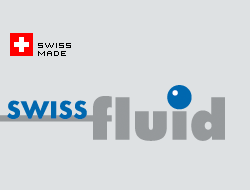

Swissfluid AG
Industriestrasse 40
CH-5600 Lenzburg
Schweiz
T +41 62 889 20 10
F +41 62 889 20 11
info@swissfluid.ch |
|
 |

Sight Glasses
SSP Sight Glasses
Our SSP Sight Glasses are ideally suited for continuous monitoring of corrosive, abrasive, or toxic process media, in liquid or gaseous state. These substances could be of caustic, explosive or poisonous nature or even constitute a fire hazard. No operator action is required to enable continuous monitoring.
Flanged SSP Sight Glasses are easily installed in horizontal or vertical ANSI or DIN piping systems. The body is clearly marked with a directional arrow.
The robust and maintenance-free design utilizes ASTM A-216 WCB (1.0619) as standard body material; bodies can also be furnished in AISI A316 stainless steel (CF-8M / 1.4408) and AISI A316L (CF-3M / 1.4404), for service in corrosive atmospheres. Face-to-face dimensions are in accordance with EN 558-1 row 1 and ASME B16.10 Table 8.
PFA and PFA-AS (anti-static) linings are mechanically locked in place. PVDF or polypropylene – lined versions are available on request.
A slight turbulence is created by the integrated drip ledge, resulting in better visibility of the flow of liquids. A PTFE ribbon is available as an option to observe the flow of gases visually.
The standard borosilicate glass plates (which meet DIN 7080 specifications) allow safe visual control of liquid or gaseous process media at all times. Optional protective foils made from FEP can be applied to the inside of the glass plates. SSP Sight Glasses can safely operate at temperatures of -40°C (-40°F) to 200°C (392°F), and operating pressures between 1mbar (0.01psi) to 16 bar (232psi).
SST Sight Glasses
SST Sight Glasses are ideally suited for continuous monitoring of corrosive, abrasive or toxic process media in liquid or gaseous state. These substances could be of caustic, explosive, or poisonous nature, or even constitute a fire hazard. No operator action is required to enable continuous monitoring.
Flanged SST Sight Glasses are easily installed in horizontal or vertical AISI or DIN piping systems. The body is clearly marked with a directional arrow.
The standard materials for the robust and maintenance-free design are AISI A316 stainless steel (CF-8M / 1.4408) and AISI A316L (CF-3M / 1.4404).
Face-to-face dimensions are in accordance with EN 558-1 row 1 and ASME B16.10 Table 8. Flanged or butt-weld end connections are available. A slight turbulence is created by the integrated drip ledge, resulting in better visibility of the flow of liquids. A PTFE ribbon is available as an option to observe the flow of gases visually.
The standard borosilicate glass plates (which meet DIN 7080 specifications) allow safe visual control of liquid or gaseous process media at all times. Metal-glass bonded plates can be supplied. All versions are available with optional protective foils made from FEP. SST Sight Glasses can safely operate at temperatures of -40°C (-40°F) to 200°C (392°F), and operating pressures between 1mbar (0.01psi) to 16 bar (232psi).
SSP-T / SST-T Tubular Sight Glasses
Our SSP-T (lined) and SST-T (unlined) Tubular Sight Glasses are ideally suited for continuous monitoring of corrosive, abrasive, or toxic process media in liquid or gaseous state. These substances could be of caustic, explosive, or poisonous nature or even constitute a fire hazard. No operator action is required to enable continuous monitoring.
Our flanged Tubular Sight Glasses are easily installed in horizontal or vertical ANSI or DIN piping systems. Face-to-face dimensions are in accordance with ASME B16.10 Table 8 and EN 558-1, row 1. Special-lengths tubular sight glasses are available upon request.
The most common materials for the mechanically locked linings (for SSP-T Tubular Sight Glasses) are PFA or PFA-AS (anti-static). These sight glasses can also be furnished with special lining materials such as ETFE, PVDF or polypropylene.
The standard acrylic glass cylinder made from PMMA-XT serves as an additional security level against exterior mechanical damage. Tubular Sight Glasses can safely operate at temperatures of -40°C (-40°F) to 200°C (392°F), and operating pressures between 1mbar (0.01psi) and 16 bar (232psi).
|
|
 |

Download Brochures
 Process Valves and Automation Process Valves and Automation
|

